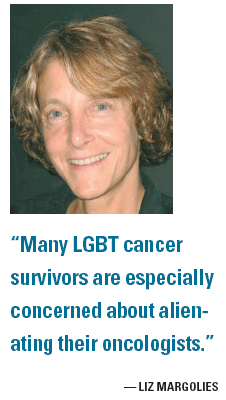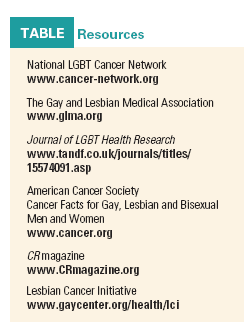Bolstering oncologists’ awareness about cancer, cancer risk in gay communities
My organization, the National LGBT Cancer Network, estimates that there are one million lesbian, gay, bisexual, and transgender (LGBT) cancer survivors in the U.S. today. While you may not know it, you likely have LGBT cancer survivors in your community.
Lesbian, gay, bisexual, and transgender people have lower screening rates compared with the general population and are often afraid to “come out” to their doctors.

My organization, the National LGBT Cancer Network, estimates that there are one million lesbian, gay, bisexual, and transgender (LGBT) cancer survivors in the U.S. today. While you may not know it, you likely have LGBT cancer survivors in your community.
Compared with the general population, LGBT people have greater cancer risks and lower screening rates, resulting in more frequent late-stage diagnoses. Part of the problem is that many LGBT women and men are afraid to “come out” to their healthcare providers, due to past discrimination. While provider bias against LGBT patients is declining, it remains quite real. Many LGBT cancer survivors are especially concerned about alienating their oncologists-the very doctors on whom they depend for treatment.
We can help eliminate healthcare disparities for the LGBT cancer community by creating safe spaces and speaking up for them. Here are some tips on how you can help.
Educate yourself about cancer risks, realities in the LGBT community
The increased cancer risks in this population are not the result of biological differences but behavior, like tobacco and alcohol use. In the lesbian population, there are higher rates of tobacco and alcohol use and obesity. Lesbians are more likely to delay childbirth or not have biological children. All of these factors have been linked to breast cancer. This could potentially increase the likelihood that lesbian women may develop the disease (J Womens Health 18:177-185, 2009; J LGBT Health Res 3:15-27, 2007).
Among gay men, those who engage in anal receptive intercourse are at an increased risk for anal cancer, which is caused by the same types of human papillomavirus (HPV) that cause cervical cancer. Some studies have found that anal HPV is present in 65% of HIV-negative gay men and in 95% of gay men who are HIV-positive.
Despite these worrisome facts, many gay men don’t come out to their healthcare providers. What’s more, doctors frequently don’t know about the simple anal Pap smear used to detect abnormal cells (Sex Transm Dis 34:170-173, 2007; 30:639-644, 2003).

There are many other challenges facing LGBT patients. For instance, same-sex partners are not always permitted in a consultation or exam room. And healthcare professionals are often unaware of the impact of cancer on the family, sexuality, and fertility of an LGBT individual (Cancer J 15:65-69, 2009). Dismantle the ‘heterosexual assumption’ Don’t assume that everyone is heterosexual. Studies show that LGBT people are willing to come out if they are invited to do so and less likely to share their sexual identity if they have to bring up the subject themselves (Cancer Causes Control 10:1009-1020, 2008).
Instead of assuming a breast cancer survivor has a husband, try asking about her family or her support system to open up the conversation. It is important to remember that people who aren’t married may be in committed, long-term relationships. Start using the word “partner” instead of husband or wife. During discussions in your support groups, try to remember that sex does not always involve vaginal intercourse.
Speak up
Cancer does not discriminate, but the healthcare system often does. The next time you are at a medical facility, imagine how it appears to LGBT patients and their families. Is it welcoming? Is there a nondiscrimination policy posted? Are there any LGBT magazines? Under “marital status” on the intake form, are there options besides “single,” “married,” “widowed,” and “divorced”? Pay attention to support groups, cancer websites, and local survivors’ events. Do their written materials and outreach effort include LGBT patients and their families? If you see ways to increase sensitivity to the needs of these survivors, speak up.